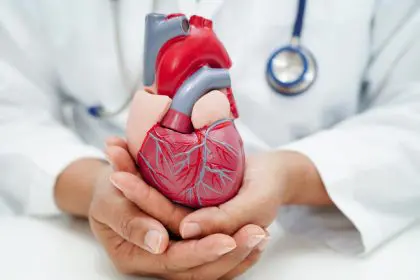For decades, maintaining a healthy weight has been touted as a primary defense against heart disease. But groundbreaking research from Harvard Medical School and Brigham and Women’s Hospital reveals that dangerous fat can hide where even the most diligent dieters and fitness enthusiasts might never suspect—inside your muscle tissue itself.
This discovery challenges conventional wisdom about who faces heart disease risk and suggests that even physically fit, normal-weight individuals might harbor a silent threat to their cardiovascular health. The findings also help explain why some slim people unexpectedly develop heart problems while others with higher body weights remain heart-healthy throughout their lives.
The surprising discovery within muscle tissue
When most people think about body fat, they picture the kind that accumulates under the skin or around internal organs. But researchers have identified a different type of fat that deserves attention: intramuscular fat that infiltrates muscle tissue itself.
Medical researchers have been looking in the wrong places. While the focus has primarily been on subcutaneous fat—the kind you can pinch—and visceral fat around organs, this research shows that fat within the muscles themselves could be a critical missing piece in understanding heart disease risk.
The comprehensive study followed 669 adults with an average age of 63 who sought medical attention for chest pain or breathing difficulties. Using advanced imaging technology, researchers measured different fat depots throughout the body, including this previously overlooked intramuscular fat.
What they discovered proved startling: for every 1% increase in what scientists call the “fatty muscle fraction,” the risk of serious heart problems rose by 7%. Even more revealing, this increased risk existed independently of other well-known heart disease factors, including body mass index, blood pressure, and cholesterol levels.
Why traditional risk assessments miss this danger
Standard medical check-ups typically measure factors like weight, blood pressure, and cholesterol levels to assess heart disease risk. Doctors might calculate body mass index (BMI) or measure waist circumference to evaluate body fat distribution. But these conventional methods fail to detect intramuscular fat.
This research explains something cardiologists have observed for years. Medical professionals have seen patients who maintain healthy weights, exercise regularly, and have perfect cholesterol numbers, yet still develop serious heart conditions. Now there’s a potential explanation for this paradox.
The traditional focus on weight also creates a false sense of security for naturally thin people who may assume their slim physique protects them from heart disease. This research suggests such assumptions could be dangerously misleading.
People often believe that maintaining a normal weight means they’re protected from heart disease. But this study shows that what’s happening inside your muscles could matter more than what you see on the scale.
How researchers uncovered this hidden risk
The Harvard team employed sophisticated cardiac imaging techniques, including positron emission tomography (PET) and computed tomography (CT) scans, to examine how fat distribution affects heart function. These advanced tools allowed them to visualize fat distribution patterns throughout the body with unprecedented detail.
Participants underwent comprehensive assessments that measured not just the amount of fat in various body depots but also evaluated coronary microvascular function—essentially how well tiny blood vessels feeding the heart muscle operate.
The results revealed that individuals with higher levels of intramuscular fat were significantly more likely to experience coronary microvascular dysfunction (CMD), a condition that impairs blood flow to the heart. This combination created a particularly dangerous scenario, as CMD itself is associated with increased risk of heart attacks, heart failure, and other serious cardiovascular events.
What makes this discovery particularly important is that it identifies a risk factor that current screening methods simply don’t detect. Intramuscular fat isn’t visible during a physical exam and doesn’t show up in standard blood tests.
The science behind why muscle fat threatens heart health
While researchers continue investigating exactly how intramuscular fat damages cardiovascular health, several plausible mechanisms have emerged. The leading theory suggests that fat within muscle tissue triggers localized inflammation, releasing harmful compounds that damage nearby blood vessels.
This inflammatory process may gradually impair the function of the microvascular system—the network of tiny blood vessels responsible for delivering oxygen and nutrients to the heart muscle. When these vessels don’t function properly, the heart becomes vulnerable to damage even if the major coronary arteries remain clear.
Another possibility involves metabolic disruption. Muscle tissue normally serves as one of the body’s primary sites for glucose metabolism. When fat infiltrates these muscles, it may interfere with this process, contributing to insulin resistance and related metabolic problems that damage cardiovascular health over time.
Research indicates that fat doesn’t just sit in tissues passively. It actively influences surrounding cells, potentially triggering cascades of harmful biological effects that extend well beyond the muscle itself.
Who faces the highest risk from this hidden threat
While the Harvard study included participants across weight categories, the findings hold particular significance for several groups. People who maintain healthy weights but lead sedentary lifestyles may be especially vulnerable, as lack of physical activity contributes to muscle loss and fat infiltration even when weight remains stable.
Older adults represent another high-risk population. As we age, muscle mass naturally declines—a process called sarcopenia—potentially creating more opportunities for fat infiltration. This helps explain why heart disease risk increases with age, even among individuals who maintain stable weights throughout their lives.
Those with certain metabolic conditions also face elevated risk. Insulin resistance and prediabetes promote fat storage within muscle tissue, potentially creating a vicious cycle where metabolic dysfunction and intramuscular fat accumulation reinforce each other.
What’s particularly concerning is that this risk factor affects people across all weight categories. It suggests a need to rethink how cardiovascular risk is assessed, especially for individuals who might appear healthy by conventional standards.
The overlooked connection to blood flow problems
One of the study’s most significant findings involves how intramuscular fat affects coronary microvascular dysfunction (CMD), a condition increasingly recognized as a major contributor to heart disease, particularly in women.
CMD affects the heart’s smallest blood vessels, reducing blood flow to the heart muscle without necessarily blocking the larger coronary arteries that cardiologists typically examine during cardiac catheterizations. This helps explain why some patients experience chest pain and other heart disease symptoms despite having “clear arteries” during standard testing.
The Harvard research revealed that individuals with higher levels of intramuscular fat were significantly more likely to develop CMD, creating a potentially dangerous combination. This connection helps explain why intramuscular fat increases heart disease risk even when other risk factors appear normal.
This finding is particularly relevant for women, who tend to develop microvascular disease more frequently than the blockages in major coronary arteries typically associated with heart attacks. It might help explain why heart disease in women is often missed until later stages.
What you can do to protect your heart
While the discovery of intramuscular fat’s role in heart disease might seem alarming, experts emphasize that proven strategies for heart health likely help address this risk factor as well.
Regular physical activity remains one of our most powerful tools, exercise, particularly strength training, helps maintain muscle quality and may reduce fat infiltration. Studies suggest that both aerobic exercise and resistance training contribute to improved muscle composition, potentially reducing intramuscular fat.
Dietary approaches that support muscle health while reducing overall body fat likely provide benefits as well. Consuming adequate protein supports muscle maintenance, while limiting processed foods and refined carbohydrates helps prevent fat accumulation throughout the body, including within muscle tissue.
The Mediterranean diet, which emphasizes olive oil, nuts, fish, fruits, and vegetables while limiting processed foods and red meat, has consistently shown benefits for heart health, this eating pattern likely helps maintain healthy muscle composition as well.
Sleep quality and stress management also deserve attention, as both chronic stress and poor sleep promote inflammation and metabolic dysfunction—factors that may contribute to fat accumulation within muscle tissue.
We’re increasingly recognizing that cardiovascular health requires a holistic approach, regular medical check-ups remain essential, but daily lifestyle choices collectively create the environment that either promotes or prevents heart disease.
The future of heart disease prevention
This groundbreaking research opens exciting possibilities for more personalized approaches to heart disease prevention and treatment. As imaging technology continues advancing, doctors may eventually be able to assess intramuscular fat as part of routine cardiovascular risk screening.
In the future, we might use specialized imaging to identify high-risk individuals before they develop symptoms, this could allow for earlier interventions targeted specifically at improving muscle quality and reducing fat infiltration.
Pharmaceutical approaches targeting muscle composition also show promise. Researchers are investigating medications that might selectively reduce fat within muscle tissue or prevent its accumulation in the first place.
What’s most exciting about this discovery is that it opens entirely new avenues for intervention, instead of focusing exclusively on lowering cholesterol or blood pressure, we might develop therapies specifically designed to improve muscle quality and reduce inflammatory processes within muscle tissue.
For now, experts recommend focusing on comprehensive heart health strategies rather than worrying about this single risk factor. Regular medical check-ups, physical activity, heart-healthy eating patterns, and stress management collectively provide the strongest protection against heart disease, regardless of whether you carry excess fat within your muscles.















